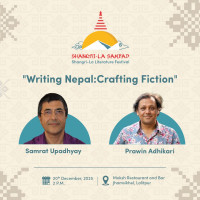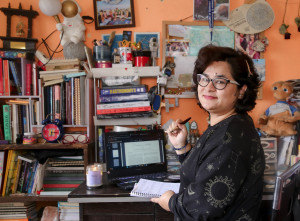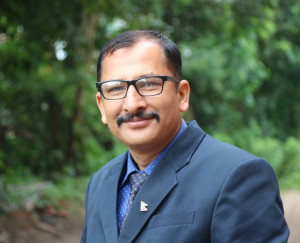Culture & Lifestyle
Fight like a girl
Boxing has become increasingly popular among women. Coaches and fighters in Kathmandu explain how this happened.
Ayse Turcan
It’s 4 pm when around 15 people gather in the training room at Boxmandu. The gym, situated on the 7th floor, offers a panoramic view of the city bathed in the warm glow of the setting sun through its large windows. But there's little time for gazing; the session begins promptly. Following a brief warm-up and stretching, the two-hour boxing class kicks off with brisk cardio exercises, followed by more technical partner drills. Alongside the ten men, five women are also participating in today's session. It’s a scene of shared effort—some punch with more force and confidence, while others take a gentler approach, reflecting varying levels of experience. What might seem ordinary is, in fact, quite noteworthy.
A few years ago, few women in Nepal took up boxing. It was considered inappropriate and seen as a violent and harmful sport with the potential to cause facial injuries. However, over the past two or three years, there has been a steady rise in the popularity of this martial art. This shift can be observed on a professional level, where female boxers are increasingly winning bouts and tournaments, for example, at the South Asian Games and the World Championship. Last year, Nepali athlete Anjani Teli, who grew up in India, made history by winning a bout in the Women’s World Boxing Championship and progressing to the quarter-finals.
The rising popularity of boxing extends to the amateur level, according to Sandeep Kuber Shrestha, the trainer and owner of Boxmandu, one of the largest boxing gyms in Kathmandu. “We have women and girls in all classes and at all levels,” he notes, highlighting the inclusive nature of the sport. Even seven-year-old girls are among those attending training sessions at the club. Shrestha sees this trend reflected in the growing interest in Webox, a competition for women that he and his wife have organised on International Women’s Day for the past three years.
In 2023, Webox took place at Lord of the Drinks (LOD), which can fit up to 2,500 people. “LOD was fully packed, and Kantipur TV even live-streamed the event,” says Shrestha, expressing pride in its success.
According to the trainer, many girls and women initially take up boxing for fitness, a sentiment shared by Hema Rai. At the age of 21, Rai joined Boxmandu in 2019 when she weighed over 75 kg. “My father was very supportive,” she recalls, recounting the beginning of what evolved into a career. While strong parental support is still an exception, her journey led her not only to fitness but also to become a competitive boxer. Starting at the state and national levels, she recently achieved success on the international stage.
At this year’s Asian U22 Championship in Bangkok, Rai secured the bronze medal in her featherweight category (57 kilos). Today, she also works as a boxing teacher at an international school.
“This development was not necessarily foreseeable,” says Rai, as trainer Shrestha recalls Rai being very shy initially.

“Boxing is a kind of magic. It gives discipline to the wild. Strength to the weak. Confidence to the shy.” This quote by famous Ukrainian boxing champion Wladimir Klitschko is painted on the wall of The Vibe Boxing Club. Six days a week, the medium-sized club in Naya Bazaar, Kathmandu, offers mixed boxing classes at different schedules, with specific sessions for girls and women only. Vibe Boxing’s owner, Ezekiel Pariyar, confirms that boxing has become increasingly popular among women.
“Somewhere between 12 to 20 girls train (boxing) here for various reasons right now,” says Pariyar. Some of them are competing in fights. With his wife Sangita Rana, who is teaching the female classes, Pariyar is promoting women’s boxing through various schemes, including discounting fees. “At the moment, we give a 50 percent discount on all classes for girls,” Pariyar explains. For girls and boys who are motivated but can’t afford the classes, he even offers a full scholarship.
Just like the Boxmandu trainers, Pariyar and Rana also figure that most women start boxing to improve their fitness, not to become a fighter. “And for self-defence,” says Rana, adding, “to overcome the bad guys!” The couple also states that martial arts helped many women training at Vibe Boxing Club overcome insecurities and gain confidence.
Despite the positive impact, Pariyar believes there are lingering prejudices against boxing. He acknowledges an improvement in recent years but highlights that some parents still discourage their daughters from participating in boxing or sports in general. He attributes this reluctance to a lack of knowledge, with people perceiving boxing as a brutal sport. Emphasising the artistic and beautiful aspects of boxing, he believes that increased awareness, facilitated by social media, contributes to changing perceptions. This, combined with broader societal developments, plays a crucial role in the growing popularity of women’s boxing.
The impact of social media is also noticeable at Boxmandu. The club actively engages on Instagram, regularly sharing videos featuring women like Rai energetically hitting the boxing pads. Shrestha notes, “A lot of girls joined our gym because of Hema,” as Rai, although now a formidable fighter, still wears a slightly shy smile. Rai’s coach believes that with dedicated training, she could become a World Champion in a few years.
Now is an opportune moment for women and girls contemplating taking up boxing, whether for fitness or even to participate in their first fight on International Women’s Day.




 13.12°C Kathmandu
13.12°C Kathmandu
.jpg&w=200&height=120)














